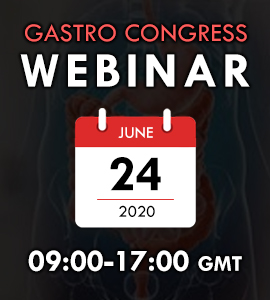
Balwant Singh Gill
Gastroenterologist, India
Title: Pathophysiology and management of “Esophageal Varices†in current practice
Biography
Biography: Balwant Singh Gill
Abstract
Esophageal Varices:
Esophageal varices are dilated submucosal distal Esophageal veins connecting the portal and systemic circulations. This happens due to portal hypertension (most commonly a result of cirrhosis), resistance to portal blood flow, and increased portal venous blood inflow. The most common fatal complication of cirrhosis is variceal rupture; the severity of liver disease correlates with the presence of varices and risk of bleeding.
Bleeding Esophageal varices:
No single treatment for bleeding Esophageal varices is appropriate for all patients and situations. An algorithm for management of the patient with acute bleeding is presented in this article. The options for long-term, definitive therapy and the criteria for selection of each are discussed.
Pathophysiology and management of Esophageal varices:
Esophageal varices are one of the most common and severe complications of chronic liver disease. New aspects in epidemiology, pathogenesis, and treatment of varices are reviewed. Sclerotherapy is the first-line treatment for acute haemorrhage. Prevention of first or recurrent bleeding is still unsatisfactory. β-Blockers are slightly superior to sclerotherapy with regard to prophylaxis of first bleeding. β-Blockers or sclerotherapy may be used for prophylaxis of recurrent bleeding. However, prophylactic treatment regimens do not have a major impact on survival. Combination treatment, new drugs, or new devices may help to improve the efficacy of prophylactic measures.
Endoscopic Therapy for Esophageal Varices:
Among therapeutic endoscopic options for Esophageal varices (EV), endoscopic variceal ligation (EVL) has proven more effectiveness and safety compared with endoscopic sclerotherapy and is currently considered as the first choice. In acute EV bleeding, vasoactive therapy (either with terlipressin or somatostatin) prior to endoscopy improves outcomes; moreover, antibiotic prophylaxis has to be generally adopted.
Variceal glue injection (cyanoacrylates) seems to be effective in the treatment of Esophageal as well as in gastric varices. Prevention of rebleeding can be provided both by EVL alone or combined with non-selective β-blockers. Moreover, EVL can be adopted for primary prophylaxis, with no differences in mortality compared with drugs, in subjects with A metaâ€analysis of endoscopic variceal ligation for primary prophylaxis of Esophageal variceal bleeding: Despite publication of several randomized trials of prophylactic variceal ligation, the effect on bleedingâ€related outcomes is unclear. We performed a metaâ€analysis of the trials, as identified by electronic database searching and crossâ€referencing. Both investigators independently applied inclusion and exclusion criteria, and abstracted data from each trial. Standard metaâ€analytic techniques were used to compute relative risks and the number needed to treat (NNT) for first variceal bleed, bleedâ€related mortality, and allâ€cause mortality. Among 601 patients in 5 homogeneous trials comparing prophylactic ligation with untreated controls, relative risks of first variceal bleed, bleedâ€related mortality, and allâ€cause mortality were 0.36 (0.26â€0.50), 0.20 (0.11â€0.39), and 0.55 (0.43â€0.71), with respective NNTs of 4.1, 6.7, and 5.3. Among 283 subjects from 4 trials comparing ligation with βâ€blocker therapy, the relative risk of first variceal bleed was 0.48 (0.24â€0.96), with NNT of 13; however, there was no effect on either bleedâ€related mortality (relative risk [RR], 0.61; confidence interval [CI], 0.20â€1.88) or allâ€cause mortality (RR, 0.95; CI, 0.56â€1.62).
Conclusion:
Compared with untreated controls, prophylactic ligation reduces the risks of variceal bleeding and mortality. Compared with βâ€blockers, ligation reduces the risk for first variceal bleed but has no effect on mortality. Prophylactic ligation should be considered for patients with large Esophageal varices who cannot tolerate βâ€blockers. Subsequent research should further compare ligation and βâ€blockers to determine the effect on mortality, and measure ligation's costâ€effectiveness.

